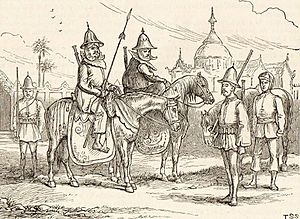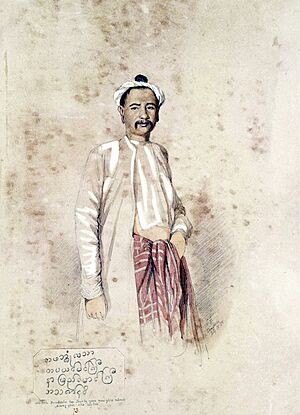Second Anglo-Burmese War facts for kids
Quick facts for kids Second Anglo-Burmese Warဒုတိယ အင်္ဂလိပ် မြန်မာ စစ် |
|||||||||
|---|---|---|---|---|---|---|---|---|---|
 Royal Burmese troops who were fighting in the Second Anglo-Burmese War in 1852 |
|||||||||
|
|||||||||
| Belligerents | |||||||||
| Commanders and leaders | |||||||||
The Second Anglo-Burmese War (Burmese: ဒုတိယ အင်္ဂလိပ် မြန်မာ စစ်) was a conflict between the Burmese Empire and the British Empire. It took place from April 1852 to January 1853. This was the second of three wars fought between these two powers in the 1800s. The war ended with a British victory. More land from Burma became part of British India.
Why the War Started
In 1852, a British naval officer named Commodore George Lambert was sent to Burma. He was sent by Lord Dalhousie, who was in charge of British India. There were some small disagreements about an older agreement called the Treaty of Yandabo.
The Burmese government tried to fix the problems right away. They even removed a governor the British complained about. However, Commodore Lambert caused more trouble. He blocked the port of Rangoon with his ships. He also took the King Pagan's royal ship. This action started the Second Anglo-Burmese War.
The war ended with the British taking over the area of Pegu. They renamed it Lower Burma. Some people, like Richard Cobden, criticized how the war began. They felt the British actions were unfair.
Key Events of the War
The British East India Company started fighting on April 5, 1852. They quickly captured the port of Martaban. On April 12, they took Rangoon. Two days later, on April 14, they attacked the famous Shwedagon Pagoda with cannons. After a tough fight, the Burmese army moved north.
The British continued to advance. They seized Bassein on May 19. On June 3, they took Pegu after more fighting around the Shwemawdaw Pagoda.
Later, in July and August, Lord Dalhousie visited Rangoon. He decided that marching to the Burmese capital was not a good idea. He thought it would be too hard and too expensive. So, the British focused on taking more land in the Irrawaddy River Valley.
On October 9, British Major-General Henry Godwin occupied Prome. He faced little resistance from the Burmese forces. These forces were led by Lord Dabayin. He was the son of Gen. Maha Bandula, who died in the First Anglo-Burmese War. In December, Lord Dalhousie told King Pagan that the province of Pegu would now belong to the British.
What Happened After the War
The British officially announced that they had taken Pegu on January 20, 1853. This ended the Second Anglo-Burmese War. No peace treaty was ever signed between the two sides.
The war led to a big change in Burma. King Pagan Min (who ruled from 1846–1852) was overthrown. His half-brother, Mindon Min (who ruled from 1853–1878), became the new king.
Mindon Min immediately tried to make peace with the British. However, the British had already moved further north. They had taken control of valuable teak forests. No new treaty was signed. But trade between British Burma and the Kingdom of Ava started again. This peace lasted until more fighting broke out in 1885–1886.
See also
- History of Burma
- Konbaung dynasty
- First Anglo-Burmese War (1824–1826)
- Third Anglo-Burmese War (1885)


